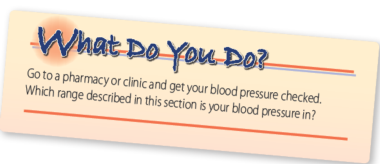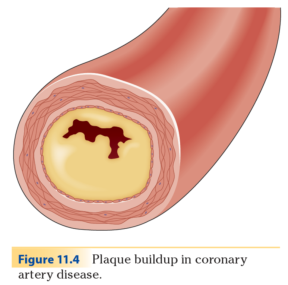Cardiovascular disease covers several common afflictions
This is an excerpt from Health and Wellness for Life With Online Study Guide by Human Kinetics.

Cardiovascular Disease
Cardiovascular disease (CVD) is an umbrella term that includes several diseases that affect the heart or blood vessels. CVD can develop even before a baby is born. Congenital heart disease is another broad term that covers a wide range of diseases and conditions that develop before birth and that can affect the formation of the heart muscle or its chambers or valves. These congenital conditions include narrowing of a section of the aorta (coarctation) or holes in the heart (atrial or ventricular septal defect; see figure 11.3). Some congenital heart defects may be apparent at birth, whereas others may not be detected until later in life (Mayo Clinic 2006). Nine out of every 1,000 babies born in the United States have a defect that originated as the heart was developing during pregnancy. Congenital heart defects are the most common birth defects (Lucile Packard Children's Hospital 2007).

When people typically think of heart disease, though, they're thinking about those that develop over time, including high blood pressure, coronary artery disease, peripheral artery disease, cardiomyopathy, aneurysm, valvular heart disease, pericardial disease, heart failure, arrhythmia, and stroke (Mayo Clinic 2006). In these forms, CVD causes more deaths for men and women than all forms of cancer combined.
High Blood Pressure
High blood pressure, or hypertension, is when blood pumps through blood vessels with excessive force against the walls. The heart has to work harder to pump the blood. Hypertension is one of the most common forms of CVD in the United States, affecting about one in three Americans. It is a precursor to many forms of coronary heart disease (CHD). Although hypertension is potentially life threatening, it's one of the most preventable and treatable types of CVD.
Blood pressure measurements provide the information that leads to a diagnosis of hypertension. Blood pressure readings have two numbers and are usually reported as one number over another number (for example, 120 over 80 mmHg). The top number describes the systolic pressure, and the bottom number describes the diastolic pressure. (Systolic arterial pressure is the peak pressure in the arteries, which occurs near the beginning of the cardiac cycle. Diastolic arterial pressure is the lowest pressure, at the resting phase of the cardiac cycle.) When diastolic pressure is high, it is usually the result of stress. The arteries are restricted during the resting stage, indicating that stress hormones are tightening the arteries. Following are the stages of hypertension (D.W. Stein 2006):
- Normal blood pressure: Less than 120 over 80
- Prehypertension: 120 to 139 over 80 to 89
- Stage 1 hypertension: 140 to 159 over 90 to 99
- Stage 2 hypertension: More than 160 over 100
Most doctors do not diagnose hypertension in just one visit. Often people have elevated blood pressure when they are ill, are nervous about visiting the doctor, or hurried to the doctor's office. Repeated readings above the normal level under various circumstances will result in a diagnosis of hypertension. However, if the blood pressure reading is over 160, the doctor will most likely require patients to return in a short time to reread their blood pressure to see if it was a fluke or to prescribe them medication to control their blood pressure if a high reading occurs again.
Coronary Artery Disease
Coronary artery disease, in the forms of arteriosclerosis and atherosclerosis, is a common form of CVD. Arteriosclerosis is when the arteries lose some of their elasticity and harden, usually as a result of aging. Atherosclerosis, on the other hand, is when a fatty material called plaque builds up in the arteries around the heart (see figure 11.4). Coronary artery disease is the buildup of plaque in the arteries that supply the heart with blood. An unhealthy diet (lots of saturated fats), lack of exercise, being overweight, and smoking are major risk factors for developing atherosclerosis (Mayo Clinic 2006). Both arteriosclerosis and atherosclerosis can result in a lack of blood flow to the heart, which in turn can lead to chest pain (angina) and heart attacks.

A heart attack is an injury to the heart muscle caused by a lack of oxygen. The medical term for a heart attack is myocardial infarction (MI). Figure 11.5 illustrates how a small blood clot or piece of plaque can break loose from an artery and block oxygenated blood from reaching the heart. The lack of oxygen causes part of the heart muscle around the blocked area to die.

Peripheral Artery Disease
Peripheral artery disease occurs when plaque builds up on the inside walls of the arteries that carry blood from the heart to the head, internal organs, and limbs. It is also known as atherosclerotic peripheral arterial disease.
Here are some signs and symptoms of peripheral artery disease:
- Pain, numbness, aching, and heaviness in the muscles
- Cramping in the legs, thighs, calves, and feet
- Weak or absent pulse in the legs or feet
- Sores or wounds on toes, feet, or legs that heal slowly, poorly, or not at all
- Color changes in skin, paleness, or blueness (cyanosis)
- Decreased temperature in one leg compared with the other leg
- Poor nail growth and decreased hair growth on toes and legs
- Erectile dysfunction, especially among men with diabetes
Cardiomyopathy
Cardiomyopathy refers to diseases of the heart muscle. Some types of cardiomyopathy are genetic, and others have causes that are less well understood. Here are some types of cardiomyopathy.
- Ischemic-Caused by loss of heart muscle from reduced coronary blood flow, sometimes as a result of anemia (low iron levels in the blood) or sleep apnea (snoring and waking up many times during the night).
- Intrinsic cardiomyopathy-Not due to any known external causes; doctors must rule out the possibility of CHD. Can be caused by alcohol, drugs, hepatitis, or viruses.
- Dilated-Heart chambers are enlarged.
- Hypertrophic-Heart muscle is thickened.
- Restrictive cardiomyopathy-Uncommon cardiomyopathy in which the walls of the ventricles are stiff, but may not be thickened, and resist the normal filling of the heart with blood.
- Idiopathic dilated cardiomyopathy-Enlarged heart without a known cause (idiopathic simply means "unknown cause"); one of the most common types of cardiomyopathy (Mayo Clinic 2006).
SHOP

Get the latest insights with regular newsletters, plus periodic product information and special insider offers.
JOIN NOW


